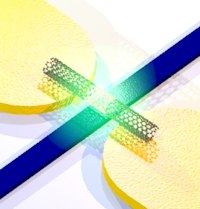
Nanophotonics and single photon detection
Using nanophotonic building blocks we develop optical integrated circuits which are able to process optical signals in analogy to electronic circuits. In such photonic circuits electrical wires are replaced by waveguides which guide light across the chip surface. This allows for realizing complex optical components, consisting of individually optimized fundamental units which are interconnected to intelligent systems. Such devices comprise for example of nanoresonators, integrated spectrometers and optical memories.
Nanostructured systems are particularly interesting for nanoanalytic applications because they allow for measuring surface effects in the optical near field with highest precision. Especially hybrid optical circuits, which combine traditionally passive materials such as silicon and dielectrics with functional nanocomponents, offer unprecedented possibilities for sensing and unconventional computing. We realize photonic computing architectures which are inspired by the function of the brain. With neuromorphic photonic circuits we implement artificial neural networks for ultrafast information processing, machine learning and artificial intelligence.
Complementary to nanophotonic systems which operate at higher optical intensities, we investigate quantum photonic architectures at ultralow intensities, down to the single photon level. We develop high performance single photon detectors integrated atop nanophotonic waveguides, leading to near-unity efficiency, negligible dark count rates and highest timing resolution. Because such detectors are realized with scalable nanofabrication techniques, we combine efficient detector arrays with nanophotonic circuits to realize functional single photon systems.
Essential for such research directions are precision nanofabrication under cleanroom conditions, precision measurements and efficient simulation techniques to predict the optical behavior of nanophotonic circuits.

